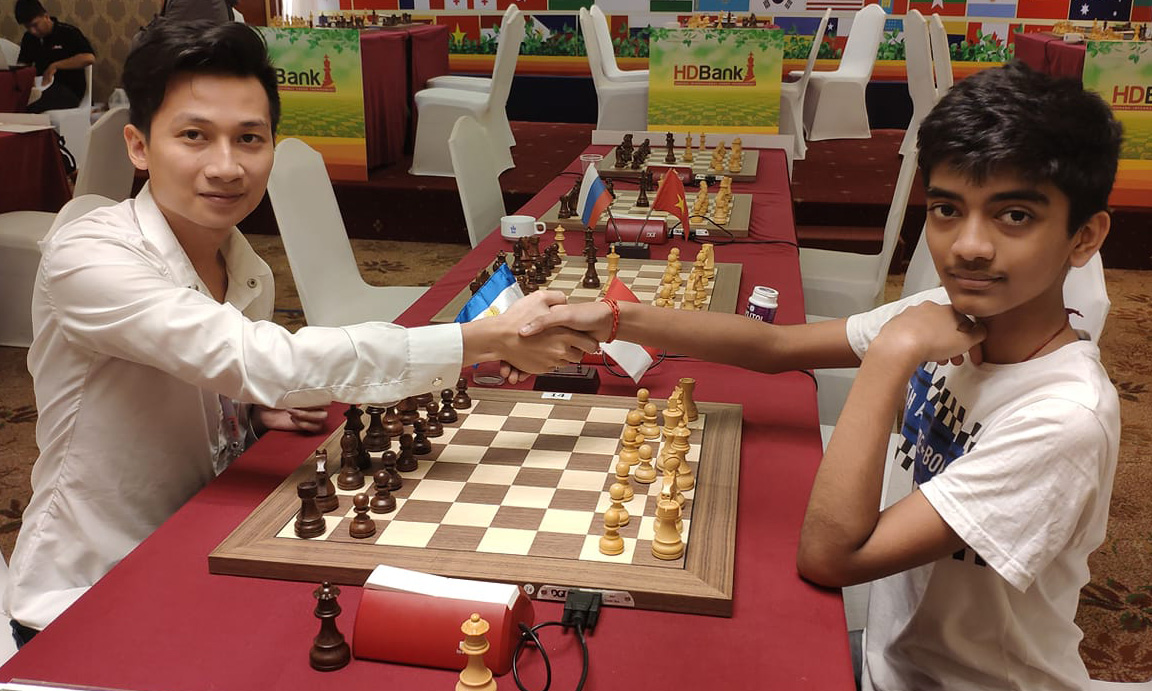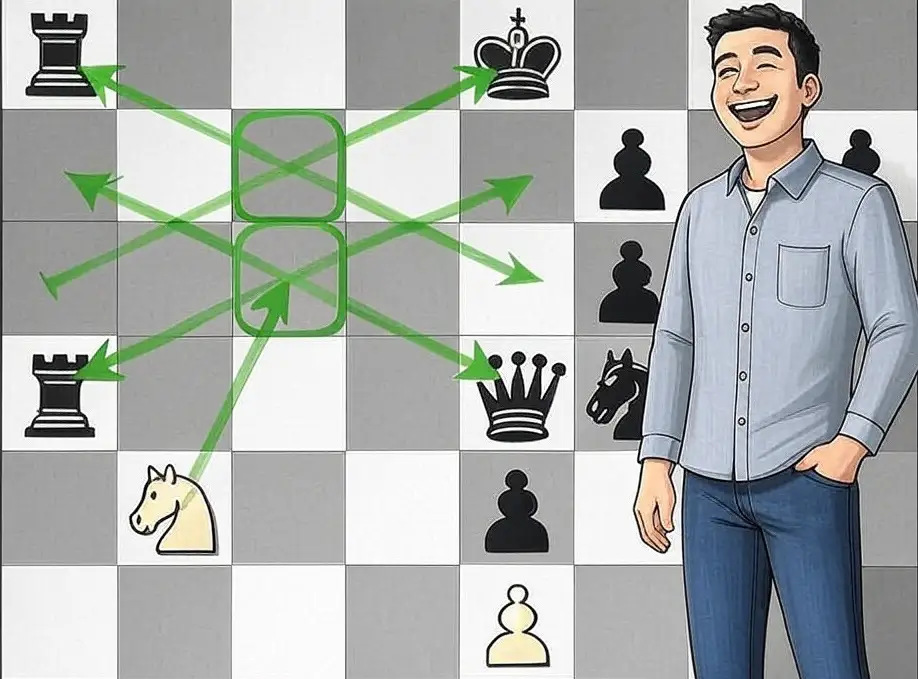Learning tactical motifs is the fastest way to improve. Below are 60 essential tactics and patterns, each explained in a few sentences so you can recognize and practice them in your own games.
- Fork
A single piece (often a knight) attacks two or more enemy pieces at once. The idea is to win material because the opponent usually cannot save everything. - Double Attack
A more general fork where any piece creates two simultaneous threats (for example, attacking a piece and checking the king). It forces your opponent to respond to one threat and often loses material on the other. - Pin
A piece is attacked and cannot move without exposing a more valuable piece (or the king) behind it. Pins can immobilize defenders and create targets. - Absolute Pin
A pin where the piece in front cannot legally move because the piece behind is the king. This is one of the strongest pins, moving the pinned piece is illegal. - Relative Pin
The piece behind is valuable but not the king (e.g., a rook behind a knight). Moving the pinned piece is legal but usually loses material. - Skewer
Like a pin but with the more valuable piece in front; when it moves, a less valuable piece behind is captured. Skewers often win material or force a worse piece exchange. - Discovered Attack
You move a piece and reveal an attack by another piece behind it. The moving piece can also create a second threat, making discovered attacks very powerful. - Discovered Check
A discovered attack where the revealed threat is a check to the king. The opponent must respond to the check, often allowing you to win material with the moving piece. - Double Check
Two pieces give check simultaneously (usually via a discovered check plus the moving piece). The only legal response is moving the king, making double checks especially forceful. - Back-Rank Mate
A rook or queen delivers mate along the back rank while the enemy king is trapped behind its own pawns. Prevent it by giving the king an escape square or exchanging heavy pieces. - Smothered Mate
A knight checkmates a king surrounded by its own pieces, typically in the corner. It often arises after a sequence of sacrifices or a knight fork plus interference. - Anastasia’s Mate
A knight and rook (or queen) coordinate to trap the king on the edge with a knight checkmate pattern. It usually involves driving the king to the corner and delivering mate with a knight supported by a rook. - Arabian Mate
A rook and knight cooperate to checkmate a king near the board edge; the knight covers escape squares while the rook mates. It’s a classic short-mate technique in attacking play. - Boden’s Mate
Two bishops deliver mate on intersecting diagonals, often after luring the king onto a vulnerable square. It’s dramatic and comes from opening diagonal lines. - Legal’s Mate
A tactical pattern where a player sacrifices material to set up a mating net, famously from an opening trap that wins quickly. It highlights the power of rapid development and king exposure. - Scholar’s Mate
A four-move mating pattern exploiting weak play around f7/f2. Easy to avoid with basic defense, but useful to recognize both to execute and to parry. - Greek Gift Sacrifice
A bishop sac on h7 (or h2) to draw the king out and start a fierce attack (Bxh7+). It works when you can follow up aggressively with queen/knight and open lines. - Clearance
You sacrifice or move a piece to clear a square or line for another piece to occupy and deliver a decisive blow. Clearance often precedes discoveries or mating attacks. - Decoy
You lure an enemy piece to a specific square where it becomes vulnerable or where it blocks a defense. Decoys can win material or open mating patterns. - Deflection
You force an opponent’s defensive piece away from its duty, often by sacrifice. Once deflected, the original target becomes undefended. - Interference
You insert a piece between two enemy pieces to break a defensive connection (e.g., between a king and its guard). Interference can destroy coordination and allow tactical shots. - Overloading
An enemy piece is given too many defensive duties; you exploit this by attacking the overloaded unit. When it can’t cover everything, you win material. - Removing the Defender
You capture or deflect a piece that is defending a critical square or piece. Removing a single defender can collapse an opponent’s position immediately. - Zwischenzug (Intermezzo)
An intermediate move inserted between an expected sequence that changes the outcome (often a check or a stronger threat). Recognizing and playing zwischenzugs turns many equal lines into wins. - Zugzwang
A position where any move worsens the player’s situation because all legal moves lose material or lead to mate. It’s a powerful endgame weapon. - X-ray Attack
A piece attacks “through” another piece, exerting pressure on a more distant target. X-rays are common with rooks and queens along files or bishops along diagonals. - Battery
Two pieces (often queen and rook, or two rooks) line up on the same file, rank, or diagonal to build combined firepower. A battery can be used for pins, discoveries, or to pile on pressure. - Windmill (See-saw)
A repeating tactic where a discovered check and a capture alternate, winning large material. Famous in some sacrificial attacks, it forces the opponent’s king to be checked repeatedly while you collect pieces. - Attraction (Lure)
You tempt the enemy king or piece to a square where it is more vulnerable, often to deliver mate or win material. Attraction is common in mating combinations. - Trapping
You limit a piece’s mobility until it becomes trapped and indefensible. Trapping is especially effective against bishops, knights, and queens that lose escape squares. - Exchange Sacrifice
Deliberately give up a rook for a minor piece to achieve dynamic gains like attack, bishop pair, or pawn structure. The sacrifice is sound when positional or tactical compensation exists. - Sacrificial Combination
A sequence of sacrifices used to break open the enemy king or net decisive material gains. Study combinations to learn how sacrifices interplay. - Opening a File
You sacrifice or trade pawns/pieces to open a file for rooks or queens to invade. Open files are highways for heavy pieces. - Clear the Line (Line Opening)
By moving or sacrificing, you open a long-range line for a bishop, rook, or queen to attack. This is central to many mating and material-winning ideas. - Perpetual Check
You force a draw by giving continuous checks that cannot be escaped without losing material or getting mated. It’s an important defensive resource. - Underpromotion
Promoting a pawn to a knight, rook, or bishop instead of a queen for immediate tactical reasons (e.g., to give check or avoid stalemate). Underpromotions to knight are the most common tactically. - Promotion Trap
You lure or force the opponent into queening in a way that allows an immediate tactic against the new queen or results in stalemate. Timing queen promotions is often tactical. - King Hunt
You chase the enemy king across the board with checks and threats, often culminating in mate. Coordinated piece activity and tempo are essential. - Sacrifice to Expose the King
Sacrificing material to rip open the king’s shelter (pawns or defenders) so heavy pieces can deliver mate or win decisive material. - Blocking (Interception)
You interpose a piece to stop a discovered attack or check, sometimes forcing unfavorable exchanges. It’s both a defensive tool and a motif to exploit when the blocking piece becomes vulnerable. - Clearing the Way (Vacating Squares)
You move a defending piece to free a crucial square for your own piece or to allow a decisive jump. Vacating squares is often subtle but decisive. - Over-extension Punishment
You exploit pawns or pieces that advanced too far without support, using tactical strikes that undermine them. Over-extended units can become tactical targets. - Pawn Break Tactics
A pawn push that opens lines at the right moment to create tactics (discoveries, pins, or attacks on the king). Successful breaks often hinge on tempo and piece placement. - Tactical Use of the Bishop Pair
Using long-range bishops to create pins, skewers, or mating threats across both wings. Coordinated bishops are excellent at creating tactical pressure. - Knight Outposts
Placing a knight on a protected, advanced square (often supported by a pawn) where it creates forks, attacks, and tactical threats. Strong outposts are tactical launchpads. - Rook Lift
Bringing a rook up the board via the third or second rank (or file) to join the attack, often creating mating pressure or double attacks. A rook lift converts a passive rook into an attacking piece. - Tempo Sacrifice
A small sacrifice to gain time (tempo) for development, attack, or creating a decisive threat. Sometimes giving up a pawn or exchange is worth the momentum. - Tactical Use of Pins and Skewers Combined
Combining pins and skewers to limit opponent responses and win material; for example, pinning a piece so a skewer later picks up the pinned unit. Layered motifs are very effective. - Calculated Sacrifice
A well-analyzed sacrifice that gives concrete compensation (mate, material, or positional advantage), not a speculative shot. Learn to calculate accurately before committing. - Blocking the Escape (Mate Net)
Constructing a net where the king’s escape squares are blocked (by pieces or pawns) then delivering mate. Many mating patterns rely on building this net step by step. - Counterattack Tactics
Creating an immediate threat (often a discovered attack or mate) that forces the opponent to address your threat instead of finishing their plan. Counterattacks can flip the initiative. - Tempo-gaining Queen Moves
Using checks with the queen to improve position or gain time to bring other pieces into attacking squares. Queen checks can be surgical if used carefully. - Sacrifice to Force Simplification
Giving material to force an exchange or simplification that wins in the endgame or removes a dangerous attacker. Often used defensively and offensively. - Blocking with a Sacrifice
Sacrificing to place a piece on a key defensive square (e.g., to block a passed pawn or a mating attack) and then exploiting that placement. The sacrificial block can be the key tactical turn. - Counter-pin
When you respond to a pin by creating a pin against your opponent’s piece, forcing them to choose between two bad options. Counter-pins can neutralize an apparent weakness. - Redistribution of Pieces
Tactically rerouting pieces to better squares (via maneuvers) to create new threats like forks or pins. Good maneuvering often precedes tactical shots. - Exploiting Bad King Placement
Targeting a king stuck in the center or exposed after castling late; central kings are vulnerable to quick tactical blows. Open lines and rapid piece activity are decisive here. - Mating Nets with Minor Pieces
Using knights and bishops to construct tight mating nets (not just heavy pieces). Minor-piece nets are subtle and lethal when coordinated. - Time (Tempo) Calculation in Attacks
Tactics depend on whether you have the time to execute sequences; counting tempi—how many moves it takes — is a tactical skill that decides many combinations. - Pattern Recognition & Combination Building
Not a single move, but the meta-tactic: recognizing multiple motifs together (fork + pin + clearance) and combining them into a winning sequence. Training patterns and solving puzzles builds this skill.

I’m Xuan Binh, the founder of Attacking Chess, and the Deputy Head of Communications at the Vietnam Chess Federation (VCF). My chess.com and lichess rating is above 2300. Send me a challenge or message via Lichess. Follow me on Twitter (X) or Facebook.






